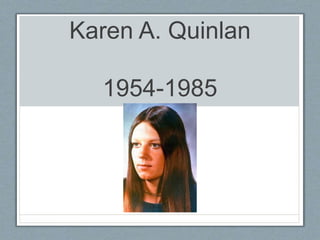
Karen A. Quinlan-Power Point-Final
- 2. About Karen Karen Ann Quinlan was an important figure in the history of the right to die controversy in the United States. At the age of 21 she became unconscious after arriving home from a party. It was later discovered that Karen had consumed diazepam (Vallum), dextroproxphene (used to treat mild pains) and alcohol causing her to collapse and stop breathing twice for 15 minutes or more before the paramedics could arrive and take her to the hospital.
- 3. What is PVS? This lack of oxygen for an extended period caused Quinlan to suffer irreversible brain damage. Her brain was damaged to the extent that she entered a persistent vegetative state. A state of completely altered consciousness. • Eyes no longer moved in the same direction together • EEG showed only abnormal slow-wave activity • Weight lose-final weight 80 pounds • Prone to unpredictable, violent thrashing of limbs • Nasogastric feeding was given and a ventilator to assist with breathing
- 4. After the Diagnosis Once she arrived at the hospital and was diagnosed as PVS she was kept alive on a ventilator for several months without improvement. Not long after the Quinlans made the decision to have Karen removed from life support, however, it was discovered that in order to carry out their wishes, they needed to petition the court.
- 5. Why? In 1975 the American Medical Association (AMA) considered removing Karen from the ventilator as euthanasia which equaled murder. At this time there was no federal or state court clarifying the rights of competent dying patients or incompetent patients. The physicians who would perform the removal feared that the Quinlans would regret their decision and sue them for malpractice.
- 6. The Ruling Hospital officials, faced with threats from the Morris County prosecutor to bring homicide charges against them, joined with the Quinlan family in seeking an appropriate protective order from the courts, before allowing the respirator to be removed. New Jersey Superior Court Judge Robert Muir Jr. denied their request in November 1975. There was no Advance Directive proving what Karen’s final wishes were and the U.S. Constitution did not define the “Right to Die”.
- 7. Appeal The Quinlan family appealed the ruling to the New Jersey Supreme Court which ruled in their favor. On March 31, 1976, the New Jersey Supreme Court rendered a unanimous decision appointing Joe Quinlan as the personal guardian of their daughter Karen with the right to determine her medical treatment, including the right to discontinue all extraordinary means of life support.
- 8. After the Appeal After much negotiation between the Quinlans and hospital staff, Karen Ann was weaned from the machine that had pumped air into her lungs for over one year. It took five days. But Karen kept breathing. She was moved to Morris View Nursing Home in June 1976. She was to breathe on her own for another nine years before dying on June 11, 1985 of pneumonia.
- 9. Karen A. Quinlan Hospice Center • Karen’s Quinlan’s family opened a hospice center in 1980 named after her. • The family was able to open this center with the money made off of the Quinlan’s book. • Every patient is treated regardless of their ability to pay. • Their goal is to ensure the patient is in peace and pain free. • http://youtu.be/mv0KxHVSlI0
- 10. Conclusion • This was the first U.S. court case to change the history of the right to die. After this case, living wills have became more popular. • The ruling gave patients and their families the right to live and die with dignity. • Current NJ Law/Ruling Quinlan, 70 N.J. 10, 355 A 2d 647 (1976), was the first major judicial decision to hold that life sustaining medical treatments may be discontinued inappropriate circumstances, even if the patient is unable or incompetent to make the decision.
- 11. Conclusion • The New Jersey Supreme Court's decision has been followed by nearly every state appellate court to consider the issue. In add ition to establishing a patient's right to refuse life sustaining medical treatments. • The Quinlan decision made clear that a decision to remove or withhold life support systems from an incompetent patient would not constitute Homicide or Medical Malpractice. This is important to note because the ruling also protects the medical profession from criminal prosecution and civil liability when removing life support from patients in a chronically vegetative state.
- 12. Works Cited • http://www.karenannquinlanhospice.org • http://en.wikipedia.org/wiki/Karen_Ann_Quinlan • Gregory E Pence “Medical Ethics Accounts of Ground- Breaking Cases” • http://legal-dictionary.thefreedictionary.com/in+Re+Quinlan For more information about the Quinlan Case you can read the actual court document @https://www.uta.edu/philosophy/faculty/burgess- jackson/In%20re%20Quinlan,%2070%20N.J.%2010,%20355% 20A.2d%20647%20(1976).pdf